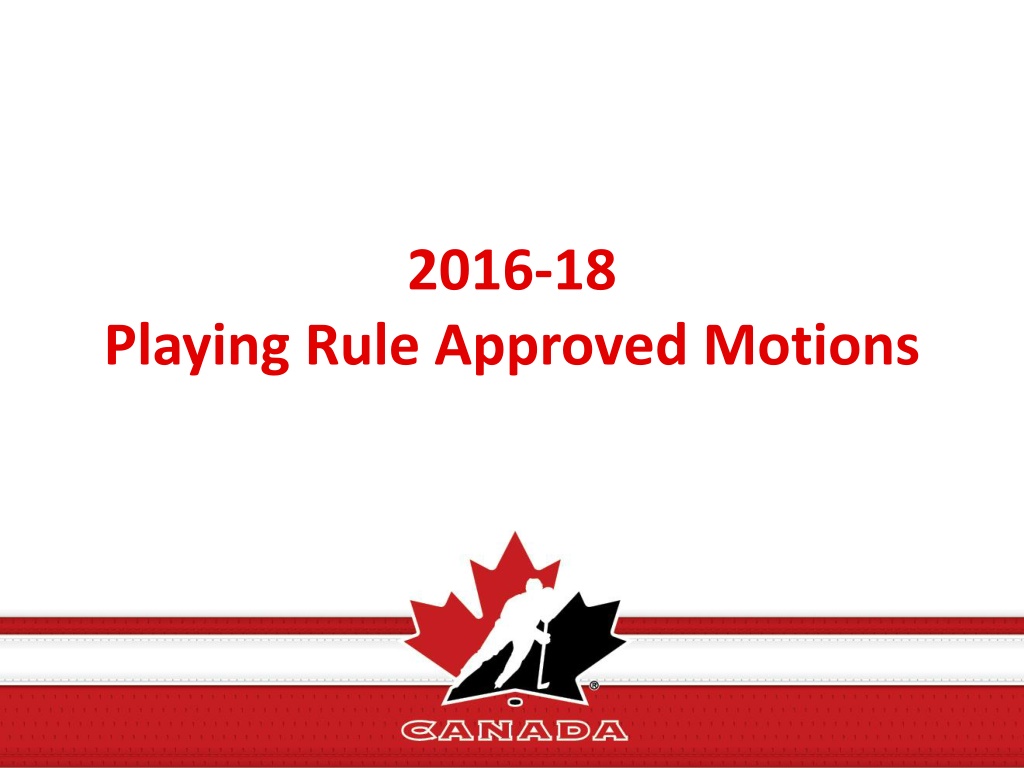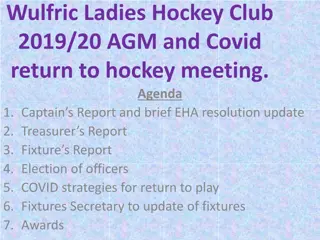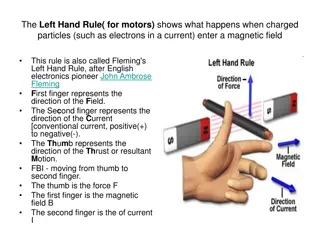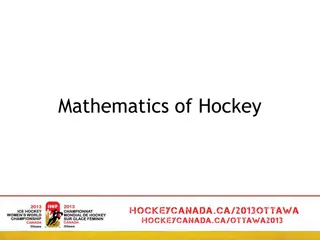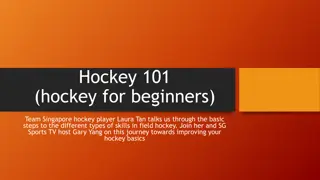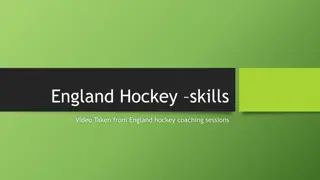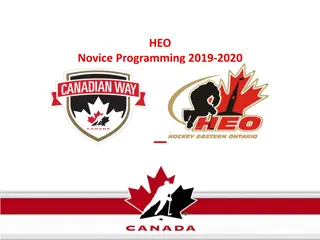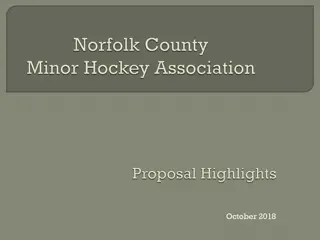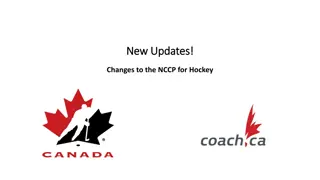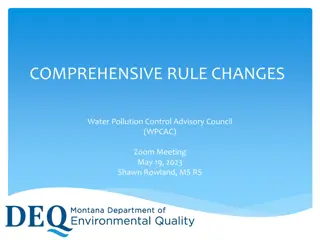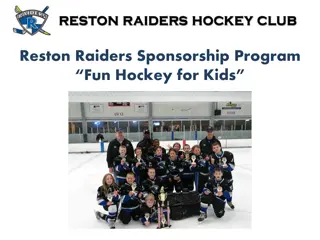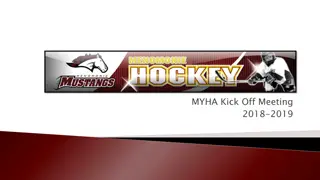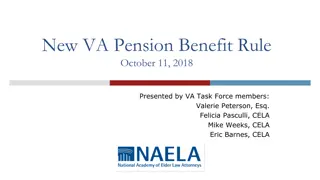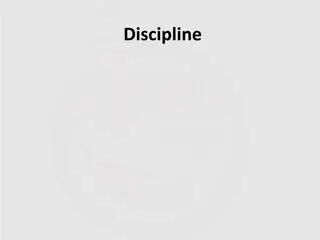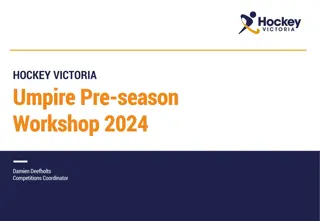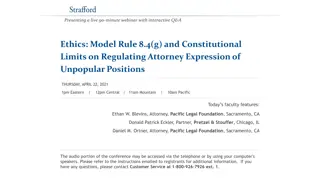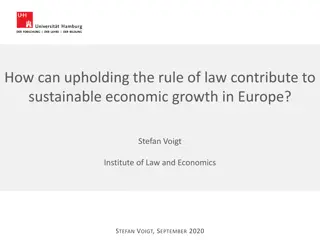Hockey Rule Changes and Regulations 2014-2018
The document outlines approved motions and rule changes for the 2014-2018 playing seasons of hockey. It covers situations such as a player taking on goaltender responsibilities, equipment requirements, and adjustments to interference/protective rules for goaltenders and players. The proposals aim to enhance player safety and ensure consistency across different levels of play.
Download Presentation

Please find below an Image/Link to download the presentation.
The content on the website is provided AS IS for your information and personal use only. It may not be sold, licensed, or shared on other websites without obtaining consent from the author.If you encounter any issues during the download, it is possible that the publisher has removed the file from their server.
You are allowed to download the files provided on this website for personal or commercial use, subject to the condition that they are used lawfully. All files are the property of their respective owners.
The content on the website is provided AS IS for your information and personal use only. It may not be sold, licensed, or shared on other websites without obtaining consent from the author.
E N D
Presentation Transcript
2016-18 Playing Rule Approved Motions
Rule 2.6 Situation 3 2014-16 WORDING: A team has only one goaltender dressed and he is injured during the course of the game. A player on the team is given the goaltender s stick, gloves, helmet and proper goaltender facial protection, but does not wish to wear the pads. QUESTION: Can the player be given the full goaltender s privileges even though he is not wearing full goaltender s equipment? ANSWER: YES, as long as the player wears the mandatory goaltender equipment as covered by the rules, helmet, proper facial protection and stick. Rule 3.3 (c),Rules 3.5 and 3.6. PROPOSED WORDING: For peewee level and up, include the pads as mandatory goaltender equipment. RATIONALE FOR CHANGE: For the players safety and to be consistent with the note that states that in levels higher than peewee, the player cannot return to the game as a player after receiving goaltender privileges.
Rule 3.6 Situations 1,4,5 & 6 2014-16 WORDING: If a player loses his helmet, facial protector, throat protector, or his chinstrap becomes undone while play is in progress, (Situation 4) Note: This interpretation also applies to facial and throat protectors. (Situation 5) Note: This interpretation also applies to facial and throat protectors. (Situation 6) Note: This interpretation also applies to facial and throat protectors. PROPOSED WORDING: Remove throat protectors from the notes in order to limit the situations to helmets and facial protectors. RATIONALE FOR CHANGE: Contradiction with rule 3.6 (f) which states The wearing of a BNQ approved throat protector is compulsory for players registered in minor and female hockey. When a player fails to wear or properly wear a throat protector at any time on the ice during the game, the team shall receive one warning and any subsequent infractions The reference to THROAT PROTECTORS HAS BEEN REMOVED FROM THESE SITUATIONS
Rule 5.3 (d) Linesmen 2016-18 Change: Added the following rule references to Rule 5.3(d) Rule 3.2(b) and 3.2(d) and Rule 3.2(e) Rules 9.2(e), 9.2(f) and 9.2(i) Rules 9.8(c) and 9.8 (d), and Deleted reference to Rule 10.15(e).
Rule 7.3 (b) Interference/Protection of the Goaltender 2014-16 WORDING: Unless the puck is in the goal crease area, a player of the attacking side may not stand in the goal crease. If the puck should enter the net while such conditions prevail the goal shall not be allowed. If an attacking player has physically interfered with the goaltender, prior to or during the scoring of the goal, the goal will be disallowed and a penalty for interference with the goaltender will be assessed and announced. 2016-18 WORDING: Unless the puck is in the goal crease area, a player of the attacking side may not stand in the goal crease. If the puck should enter the net while such conditions prevail, the goal shall not be allowed. However, if an attacking player is in the goal crease but does not interfere with the goaltender and another attacking player (who is outside the goal crease) scores, the goal shall be allowed provided that the player who is in the goal crease does not attempt to play the puck, interfere with the play, obstruct the goaltender s view or his movements. RATIONALE FOR CHANGE: Promote offense by not cancelling a goal without any direct consequence on the play.
Rule 7.4 (b) Tripping Revision to 7.4 (b) RATIONALE FOR CHANGE: The players safety, elimination of injuries, namely head injuries resulting from a fall without protection. We must eradicate dangerous and unprovoked gestures from the game.
Rule 10.2 (a) 2014-16 WORDING: The players taking the face-off shall stand squarely facing their opponents end of the rink, approximately one stick length apart with the full blade of the sticks flat on the ice. When the face-off takes place at any of the face-off spots in the end zones, the players taking part in the face-off shall take their positions so that they will stand squarely facing their opponents end of the rink The sticks of both players facing-off shall have the toe of the blade touching within the designated white area. 2016-18 WORDING: The players taking the face-off shall stand squarely facing their opponents end of the rink, approximately one stick length apart with the toe of the blade on the ice When the face-off takes place at any of the face-off spots in the end zones, the players taking part in the face-off shall take their positions so that they will stand squarely facing their opponents end of the rink The sticks of both players facing-off shall have the toe of the blade touching within the designated white area
Rule 10.4 Situation 12 CURRENT WORDING: None (addition of a situation) 2016-18 WORDING: A goal is scored. However, the back of the net is lifted when the puck crosses the red line. Is the goal allowed? YES, if the net is still in/on its moorings.
